|
Timeline
1977-1979
Advanced Dungeons & Dragons
1st Edition
(Core rule books and Monster Manual)
1983
Advanced Dungeons & Dragons
1st Edition reprinted with new cover
1989
Advanced Dungeons & Dragons
2nd Edition
1993
Advanced Dungeons & Dragons
2nd Edition
Monsterous Manual
(replaces Monsterous Compendium)
1996
Advanced Dungeons & Dragons
2nd Edition Revised
(Core rule books)
2000
Advanced Dungeons & Dragons is discontinued and merged with Dungeons & Dragons branch. The result is D&D 3rd edition
See D&D history |
Brief History of Advanced Dungeons & Dragons

Dungeons & Dragons (abbreviated as D&D or DnD) is a fantasyrole-playing game (RPG) originally designed by Gary Gygax and Dave Arneson, and first published in 1974 by Tactical Studies Rules, Inc. (TSR). The game has been published by Wizards of the Coast since 1997. It was derived from miniature wargames with a variation of the Chainmail game serving as the initial rule system. D&D's publication is widely regarded as the beginning of modern role-playing games and the role-playing game industry.
D&D departs from traditional wargaming and assigns each player a specific character to play instead of a military formation. These characters embark upon imaginary adventures within a fantasy setting. A Dungeon Master serves as the game's referee and storyteller, while also maintaining the setting in which the adventures occur. The characters form a party that interacts with the setting's inhabitants (and each other). Together they solve dilemmas, engage in battles and gather treasure and knowledge. In the process the characters earn experience points to become increasingly powerful over a series of sessions.
The early success of Dungeons & Dragons led to a proliferation of similar game systems. Despite this competition, D&D enjoys a dominant market position in the role-playing game industry. In 1977, the game was split into two versions: the more loose, open framework game system of Dungeons & Dragons and the much tighter and more structured game system of Advanced Dungeons & Dragons (abbreviated as AD&D or ADnD). AD&D 2nd Edition was published in 1989.
In 1997, a near-bankrupt TSR was purchased by Wizards of the Coast. Following three years of development, Dungeons & Dragons 3rd Edition was released in 2000. The original version of the game was discontinued and the AD&D version was renamed simply Dungeons & Dragons with the release of its 3rd edition.These rules formed the basis of the d20 System that is available under the Open Game License for use by other publishers. Dungeons & Dragons version 3.5 was released in June 2003, with a 4th edition in June 2008.
As of 2006, Dungeons & Dragons remained the best-known and best-selling role-playing game, with an estimated 20 million people having played the game and more than US$1 billion in book and equipment sales.The game has been supplemented by many pre-made adventures as well as commercial campaign settings suitable for use by regular gaming groups. Dungeons & Dragons is known beyond the game for other D&D-branded products, references in popular culture and some of the controversies that have surrounded it, particularly a moral panic in the 1980s falsely linking it to Satanism and suicide.The game has won multiple awards and has been translated into many languages beyond the original English.
(Extract from wikipedia.com)
AD&D: Overview of the different versions
In 1977, TSR created the first element of a two-pronged strategy that would divide the D&D game for over two decades:
1. Dungeons and Dragons series
2. Advanced Dungeons & Dragons series
Advanced Dungeons & Dragons was designed to create a tighter, more structured game system than the loose framework of the original game. While seen by many as a revision of the original D&D.AD&D was at the time declared to be "neither an expansion nor a revision of the old game, it is a new game". The AD&D game was not intended to be directly compatible with D&D and it required some conversion to play between the rule sets.The term Advanced described the more complex rules and did not imply "for higher-level gaming abilities".
1977-1979 Advanced Dungeons & Dragons 1st Edition
(Core rule books and Monster Manual)
 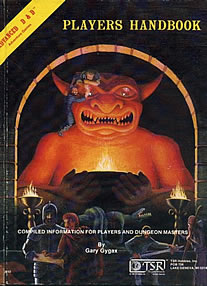 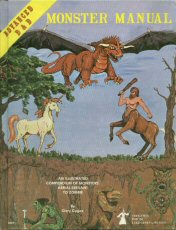
Dungeon Master Guide Players Handbook Monster Manual
The AD&D books were first published between 1977 and 1979. It was not named "1st Edition"
until after the 2nd Edition came out in the late 1980s.
An updated version of D&D was released as Advanced Dungeons & Dragons (often abbreviated to AD&D).
This was published as a set of three rulebooks, compiled by Gary Gygax, between 1977 and 1979, with additional supplemental volumes coming out over the next ten years. The AD&D rules are much better organized than the original D&D, and also incorporate so many extensions, additions, and revisions of the original rules as to make a new game. The term "Advanced" does not imply a higher level of skill required to play, nor exactly a higher level of or better gameplay; only the rules themselves are a new and advanced game. In a sense this version name split off to be viewed separately from the basic version below. The three core rulebooks are the Monster Manual (1977), the Players Handbook (1978), and the Dungeon Master's Guide (1979); later supplements included Deities and Demigods, Fiend Folio(another book of monsters produced semi-autonomously in the UK), Monster Manual II, and Unearthed Arcana(which took most of its additional playing information from The Dragon magazine). This was followed by a fairly constant addition of more specific setting works and optional rule supplements.
Some of the major differences to the D&D branch were:
The game rules were reorganized across three hardcover rulebooks (the Player's Handbook, Dungeon Master's Guide, and Monster Manual) rather than one boxed set (of three books, Men & Magic, Monsters & Treasure, and The Underworld and Wilderness Adventures), and a series of supplemental booklets.
Supplemental rules cut included hit locations.
The Chainmail-based combat system was completely abandoned.
Many details in class abilities were altered and clarified.
Character classes (Bard, Illusionist and Ranger) that had only appeared in magazine publication were added to the game.
Alignment is broken down into two polarities, "ethics" being Lawful, Neutral or Chaotic, and "morals" being Evil, Good, or Neutral, so there are now nine alignments: Lawful Good, Neutral Good, Chaotic Good,
Lawful Neutral, True Neutral, Chaotic Neutral, Lawful Evil, Neutral Evil and Chaotic Evil.
Character classes from Original Dungeons & Dragons supplemental material
(Paladin, Thief, Assassin, Monk and Druid) are added in the core rules.
Fighting Men are renamed Fighters.
The relationship between race and class is changed. In the original Dungeons & Dragons, Elf, Dwarf, and Hobbit are considered classes, where in Advanced Dungeons & Dragons the players select races and classes independently.
1983 Advanced Dungeons & Dragons 1st Edition - Reprint
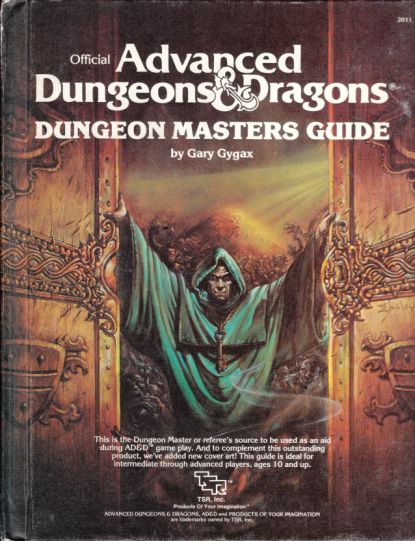  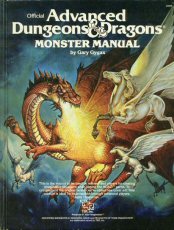
Dungeon Master Guide Players Handbook Monster Manual
AD&D had multiple printings; after the 10th printing, the books got new covers. But content were merely the same.
1989 Advanced Dungeons & Dragons 2nd Edition
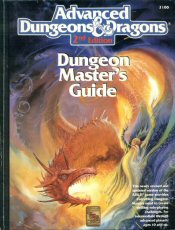 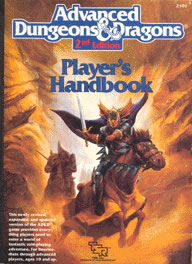 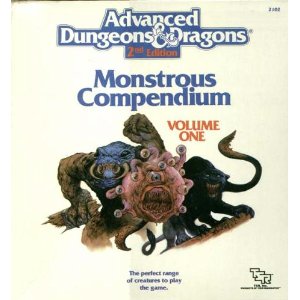
Dungeon Master Guide Players Handbook Monster Compendium (Binder)
In 1987, a small team of designers began work on the second edition of the AD&D game, beginning the most massive coordinated task ever undertaken by TSR to date, which would take nearly two years to complete.
In 1989, Advanced Dungeons & Dragons Second Edition was published, featuring new rules and characters. By the end of its first decade, Advanced Dungeons & Dragons had expanded to several rulebooks, including
three monster manuals, and two books governing character skills in wilderness and underground settings. Initially, the second edition would consolidate the game, with three essential books to govern Dungeon Masters
and players alike. Periodically, TSR published optional rulebooks for character classes and races to enhance game play.
The combat system was changed. The minimum number required to hit a target uses a mathematical formula in which the defender's AC (armor class) is subtracted from the attacker's THAC0 (to hit armor class zero) instead of
1st edition's attack matrix tables. Distances are based around in-game units (feet) rather than miniatures-board ones (inches). Demi-human races are given higher level maximums to increase their long-term playability, though they are still restricted in terms of character class flexibility. Critical hits are offered as optional rules.
Moreover, the release of AD&D2 corresponded with a policy change at TSR. An effort was made to remove aspects of the game which had attracted negative publicity, most notably the removal of all mention of demons and devils (although equivalent monsters were later added, now renamed tanar'ri and baatezu respectively). Moving away from the moral ambiguity of the First Edition Advanced Dungeons & Dragons, the TSR staff eliminated character classes and races like the assassin and the half-orc, and stressed heroic roleplaying and player teamwork. The target age of the game was also lowered, with most 2nd edition products being aimed primarily at teenagers. The Second Edition art and marketing were also modified to appeal more to female players.
The game was once again published as three core rulebooks which incorporated the expansions and revisions which had been published in various supplements over the previous decade. However, the Monster Manual was replaced by the Monstrous Compendium, a loose-leaf binder in whichevery monster is given a full page of information,
the justification being that packs of new monsters (often setting specific) could be purchased and added to the binder without the expense or inconvenience of a separate book. The concept behind the loose-leaf binder was it would allow updating the book. Originally this was considered for all the core rulebooks, based on the concept that had been used by Avalon Hill for Advanced Squad Leader. While eventually adopted only for the Monstrous Manual, it was abandoned because of the issues of wear and difficulties in keeping alphabetic order when many pages had been printed with more than one monster. Besides the formatting, the major
change in the contents of the Monstrous Compendium is greatly increasing the power of dragons. This was done to counter the perception of the relative weakness of the game's "name" monster.
For the major differences to the D&D branch please read below under the revised 1995 edition as the same differences apply.
1993 Advanced Dungeons & Dragons 2nd Edition
Monsterous Manual (replaces Monsterous Compendium)
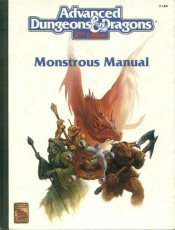
Monster Manual
The Monsterous Compendium and the idea of a loose-leaf binder was eventually dropped and the Compendium
was replaced by the hardcover Monstrous Manual in 1993.
1996 Advanced Dungeons & Dragons 2nd Edition - Revised
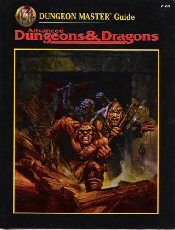 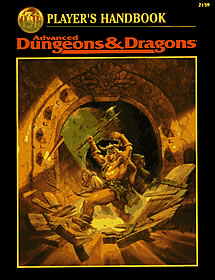 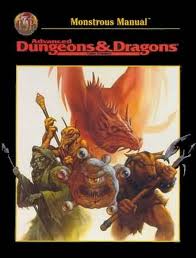
Dungeon Master Guide Players Handbook Monster Manual
(same as 1993 version)
In 1995, the core rulebooks were slightly revised and a series of Player's Option manuals were released as "optional core rulebooks". Although still referred to by TSR (and later Wizards of the Coast) as the 2nd Edition,
this revision is seen by some fans as a distinct edition of the game and is sometimes referred to as AD&D 2.5.
In 1997, TSR considered filing for bankruptcy but was purchased by former competitor Wizards of the Coast.
Some of the major differences to the D&D branch were:
Half-orcs are removed from the Player's Handbook.
Character classes are organized into four groups: Warrior (Fighter, Paladin, Ranger), Wizard (Mage, Specialist Wizard), Priest (Cleric, Druid), and Rogue (Thief, Bard).
Assassins and Monks are removed from the game as character classes.
"Magic-users" are renamed "mages".
Illusionists are made into a subtype of the Wizard class, along with new classes specializing in the other seven schools of magic (which were first introduced in Dragonlance Adventures).
Bards are made a normal character class, rather than the multiple-classed character that they are in 1st Edition, although they still possess elements of fighters, thieves, and mages.
Rangers are changed dramatically, both thematically and mechanically, from a heavily armored, commando-style survivalist and "giant-class" monster hunter, to a much more nature oriented, lightly armored,
two-weapon-wielding, Druid influenced nature warrior.
Proficiencies are officially supported in the Player's Handbook and many supplements, rather than being an optional add-on.
Attack matrices are replaced with a mathematical formula involving a character stat called "THAC0" (To Hit Armor Class 0), and the table printed only once in the Dungeon Masters Guide is reprinted in
the second edition Player's Handbook and Dungeon Master's Guide.
References to "segments" (individual units of time representing one phase of initiative, or 6 seconds of game-time [simulated time]) are removed from the game; instead, actions are given an "Initiative Modifier". "Melee rounds" are unchanged, representing one minute of game-time, with a "turn" representing ten rounds (ten minutes). An optional alternative where one "melee round" represents 12–15 seconds of "game-time" is presented in the
Player's Option: Combat & Tactics book, first of the so-called 2.5 Edition.
Other changes are made to combat including the function of weapon speed, initiative, and surprise rules.
Priest and Druid spells are organized into themed "spheres" that are similar to the wizard spell schools that
had been introduced in Dragonlance Adventures, with access to spheres being determined by the priest's class and deity.
Descriptions of artifacts (unique magic items) are removed from the Dungeon Master's Guide.
Many utilities, including tables for random generation of dungeons, are removed from the Dungeon Master's Guide.
Exchange rates for the low-valued coins are doubled; it now takes only 100 copper pieces or 10 silver pieces to make one gold piece. Coin weights changed from 10/lb (1st edition) to 50/lb. (second edition).
The hardcover Monster Manual was initially replaced by the looseleaf binder-format Monstrous Compendium; but this was eventually replaced by the hardcover Monstrous Manual.
Fiendish and angelic creatures (demons, devils, daemons, devas, solars, etc.) are removed from the game, as are spells that allowed such creatures to be summoned or controlled. These creatures were later renamed and
modified in the Monstrous Compendium supplement on the Outer Planes.
Psionics are no longer included in the Player's Handbook, though they later appeared in their own supplement.
Maximum level is standardized at 20 rather than varying by class.
Magic resistance is changed so that a mage above 11th level would not impose a 5% penalty per mage level above 11th on an unwilling subject the mage is casting a spell on.
2000 Advanced Dungeons and Dragons removed from product programme
Advanced Dungeons & Dragons is discontinued and merged with Dungeons & Dragons branch.
The result of this is D&D 3rd edition
See D&D history from here................
|